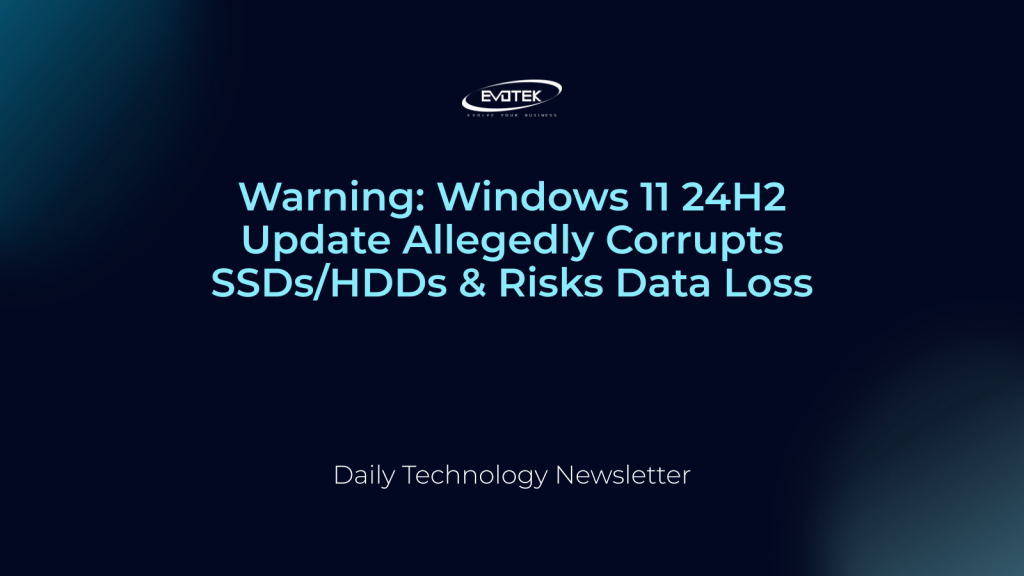A recent security update for Windows 11 24H2, identified as KB5063878, is reportedly causing severe storage issues, including drive failures and potential data corruption. This development follows Microsoft’s release of an important Defender update last week, aimed at combating the widespread Lamma stealer across new Windows 10 and 11 ISO installations. While the KB5063878 update initially faced installation hurdles, displaying a 0x80240069 error code—which Microsoft has since resolved—new reports indicate a more critical problem at hand.
The Alarming Discovery
According to a new report translated from Japanese, the Windows 11 24H2 update is triggering profound storage failures. Users are experiencing drives becoming inaccessible, with their critical SMART (Self-Monitoring, Analysis and Reporting Technology) data becoming unreadable by the operating system. This alarming issue purportedly surfaces during periods of intensive write operations to certain NVMe SSDs and traditional HDDs, specifically when continuous sustained writes exceed approximately 50 GB and controller usage surpasses 60 percent. The report ominously warns of a “high likelihood of file corruption when symptoms occur.”
Technical Insights and Recurring Issues
Speculation points to a potential malfunction within the drive’s cache subsystem or a suspected memory leak in Windows’ OS-buffered cache region as the root cause. Affected users consistently report the issue recurring predictably after a system reboot, which offers only a temporary restoration of drive visibility without resolving the underlying fault. Further analysis suggests that SSDs built on Phison NAND controllers, particularly DRAM-less models, exhibit failures at lower write volumes. Intriguingly, some enterprise-grade HDDs are also displaying comparable symptoms under similar intensive write conditions.
The current situation bears a striking resemblance to the persistent WD SN770 host memory buffer (HMB) flaw, an issue Microsoft had reportedly addressed in October 2024. However, the problem resurfaced in June 2025, hindering Windows 11 24H2 installations for some WD/SanDisk drives due to lack of proper firmware patches. Unfortunately, in this new wave of issues, restricting or disabling HMB has shown no improvement, deepening concerns about the update’s stability.
Scope and Testing Methodology
The initial reports stem from a Japanese PC builder and enthusiast, with anecdotal comments on their social media thread suggesting others in the region might be encountering similar challenges. This raises the possibility of a regional or hardware-specific impact.
To better understand the scope of the problem, the tester provided detailed results from evaluating 21 different drives through a series of rigorous steps. Each step involved restarting the PC to ensure the drive cache was cleared before proceeding:
- Step 1: Copy the entire “CyberPunk2077” data folder (92.16GB) from a Steam library to the test drive.
- Step 2: Prepare a 62.42GB file containing 150 video files (approx. 250MB each), compressed into a 7z archive. Write this archive to the storage device.
- Step 3: Decompress the 7z archive (from Step 2) within the storage device, writing the extracted files to the same device.
The test results categorized drive behavior as:
- Good: No errors encountered.
- NG Lv. 1 (Not Good Level 1): Drive becomes inaccessible but is recoverable by rebooting the system.
- NG Lv. 2 (Not Good Level 2): Drive becomes inaccessible and is unrecoverable, indicating a severe failure.
As these reports continue to surface, users are advised to exercise caution with the latest Windows 11 24H2 update, especially if engaging in heavy write operations, until Microsoft formally acknowledges and addresses these critical storage issues.

 日本語
日本語 한국어
한국어 Tiếng Việt
Tiếng Việt 简体中文
简体中文